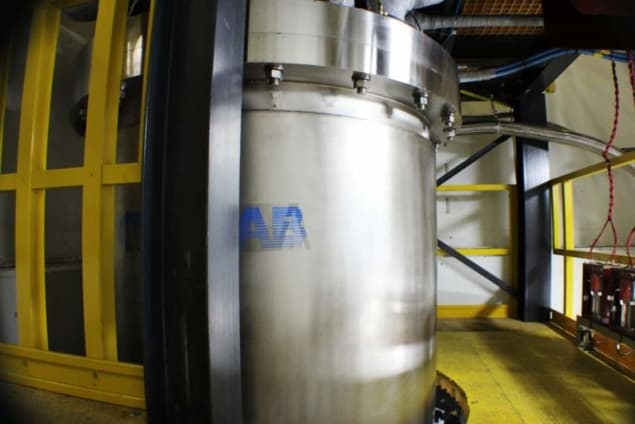
High-temperature superconductivity was first discovered in 1986, but the physics underlying the phenomenon is still shrouded in mystery. In 1990 researchers discovered that, above their superconducting transition temperatures, the archetypal high-temperature superconductors, the cuprates, can behave as “strange” metals whose electrical resistance does not vary as expected with temperature. Now, researchers led by Arkady Shekhter of the National High Magnetic Field Laboratory in the US have shown that the same strange behaviour applies to the way their resistance varies with magnetic field. The results could have fundamental implications for our understanding of the nature of superconductivity and far beyond.
While the traditional BCS theory of superconductivity (named after its developers Bardeen, Cooper and Schrieffer) cannot explain superconductivity above about 30 K, cuprates have been shown to retain their superconducting properties at temperatures of up to 130 K. But even when the materials do finally relinquish their superconductivity, cuprates are still puzzling because of their unusual metallic behaviour.
From conventional to strange
According to Shekhter, the properties of conventional metals can be predicted from Fermi-liquid theory – an inspired, intuitive approximation of the quantum-mechanical behaviour of metallic materials. This theory, developed by the Soviet physicist Lev Landau, treats large numbers of electrons as quasiparticles. “Any material has an enormous amount of electrons, so there are no exact solutions,” explains Shekhter. “Fermi-liquid theory is not the only behaviour consistent with a material being a metal and being quantum mechanical – but it’s the one we know about and the one that works for pretty much any metal we encounter in normal life.” Apply it to the cuprates, however, and things get weird.
Fermi-liquid theory predicts that, at low temperatures, the resistance of metals should depend on the square of temperature. However, cuprates’ resistance varies linearly with temperature down to the point at which they become superconducting. A wide variety of other, similar “strange” metals, or non-Fermi liquids, have subsequently been discovered – many of them not superconductors. “There is no theoretical explanation for temperature-in-linear resistivity at the moment,” says Louis Taillefer of the University of Sherbrooke in Quebec, Canada. “It remains a baffling result.”
In the absence of such an explanation, researchers have drawn inspiration from other areas of fundamental physics. Theoretical physicist Jan Zaanen of the University of Leiden in the Netherlands has suggested that the phenomenon may result from the breakdown of the Pauli exclusion principle, so that all the particles become entangled with each other – a concept he has described as “unparticle physics”. String theorists have even drawn parallels between the physics of strange metals and the properties of charged black holes.
Superconductors in magnetic fields
In 2016 a research team led by James Analytis of the University of California, Berkeley, discovered a curious feature of the strange-metal state of an iron pnictide superconductor. At high fields, they found, the resistance is perfectly proportional to the field. As with temperature, Fermi-liquid theory predicts it should be proportional to its square.
In this new research, Shekhter – a co-author of the 2016 study – worked with colleagues in the US, Columbia and Germany to ascertain whether the same “B-linear resistivity” was also seen in cuprates. They tested the resistance of thin films of strontium-doped lathanum cuprate, finding it was linearly proportional to magnetic field across a wide range of temperatures at fields up to 80 tesla – the highest they tested. Shekhter says that these results provide crucial confirmation that strange metals cannot be described by Fermi-liquid theory.

“Linear-in-temperature behaviour offers certain wiggle room to take the conventional language of metals and make it a bit more complex,” he explains. “Once you have this very unusual magnetic-field behaviour at high fields it leaves much less room for speculation. As far as I know the leading theorists are still puzzled.”
Taillefer agrees. “You cannot propose to understand anything about T-linear resistivity unless your understanding includes the cuprates, so this B-linear resistivity would not have been treated as a universal strange-metal phenomenon unless it had been seen there too,” he says.
He describes the present paper, in which he was not involved, as “a tantalizing result that’s very significant if it turns out to be true”. His caution arises from the fact that the range of fields tested is relatively small. “Superconductivity in these cuprates is very strong, so you actually need of order 60 or 70 T before you can look at the normal-state resistivity,” he explains. “So even though they went to 80 T – which is very strong – you don’t have a great range of field to see whether the relationship is linear or not.”
Jan Zaanen, meanwhile, is excited. “The present work is just part of a large development that is presently gathering steam in the experimental community,” he says. “Quite unusually, it is inspired by cutting edge developments in fundamental theoretical physics involving string theory, quantum information and many-body condensed matter physics, which went through a seredipituous convergence in recent years.”
“This is not run-of-the-mill,” Zaanen continues, “but instead potentially a ground-breaking development in fundamental physics, with ramifications for benchmarking quantum computers and even quantum gravity.”
The research is published in Science.



